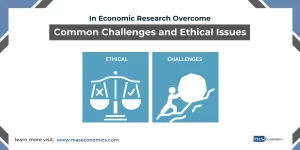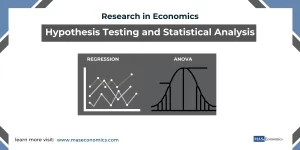Research in economics is a methodical journey aimed at solving problems, testing hypotheses, and generating insights that can shape policy, business decisions, and theoretical advancements. The economic research process provides a structured approach that helps economists navigate the complexities of real-world economic phenomena and ensures that findings are both reliable and relevant.
The research process in economics can be broken down into several critical stages: defining the problem, developing a theoretical framework, collecting data, and conducting analysis. Each of these stages plays a vital role in ensuring the rigor and validity of the research. This article will break down each step in detail, with practical examples to illustrate how the process unfolds in economic research.
Step 1: Defining the Research Problem
The first step in the research process is identifying and defining a clear research problem. This involves selecting a relevant economic issue, formulating research questions, and outlining the scope of the study. A well-defined problem sets the stage for the entire research process by focusing the analysis on specific objectives.
Example: Research on Minimum Wage Effects
An economist might be interested in understanding how increases in the minimum wage affect employment levels. In this case, the research problem would be: What is the impact of minimum wage increases on employment in low-wage industries?
Best Practices for Defining the Research Problem:
- Be Specific: A vague research question will lead to inconclusive results. Instead, focus on clear, specific objectives.
- Relevance: Ensure the problem addresses a significant issue in economics, such as employment, inflation, or income inequality.
- Feasibility: Consider whether the problem can be realistically researched within the available resources, data, and time constraints.
Step 2: Developing a Theoretical Framework
Once the problem has been defined, the next step is to build a theoretical framework that guides the research. A theoretical framework is a conceptual model that helps researchers understand the relationships between variables. In economics, this often involves drawing from existing theories to explain the phenomena being studied.
Example: Using the Phillips Curve
In the study of inflation and unemployment, an economist might use the Phillips Curve as the theoretical framework. This theory suggests an inverse relationship between inflation and unemployment in the short run, which will guide the research in examining how changes in inflation affect job markets.
Best Practices for Developing a Theoretical Framework:
- Draw on Established Theories: Use existing economic theories or models to form the foundation of your research.
- Identify Key Variables: Define the independent and dependent variables. For example, in the Phillips Curve model, inflation is the independent variable, and unemployment is the dependent variable.
- Develop Hypotheses: Based on the theoretical framework, formulate hypotheses that will be tested in the analysis.
Step 3: Data Collection
Data collection is one of the most critical stages in the economic research process. The quality and accuracy of the data significantly affect the validity of the research findings. Data can be gathered through primary sources (surveys, experiments, interviews) or secondary sources (government databases, industry reports, academic publications).
Example: Collecting Data on Minimum Wage
To study the impact of minimum wage on employment, the researcher might collect data on wage levels, employment figures, and industry performance from government labor statistics and business reports over several years. This time-series data can be used to analyze trends before and after minimum wage increases.
Best Practices for Data Collection:
- Choose the Right Data Sources: Use reliable and relevant data, such as government databases, academic journals, or financial reports.
- Ensure Data Accuracy: Check for missing data or errors and clean the dataset before analysis.
- Consider Sample Size: Ensure that the dataset covers a sufficiently large sample to provide statistically significant results.
Step 4: Data Analysis
After data collection, the next step is analyzing the data to test the hypotheses and answer the research questions. In economics, this often involves the use of econometric methods such as regression analysis, time series analysis, or panel data analysis. The goal is to identify patterns, relationships, and causal effects between the variables under investigation.
Example: Regression Analysis on Wage Data
In the study of minimum wage and employment, the economist might use a regression model to estimate the impact of minimum wage increases on employment levels. The dependent variable (employment levels) is regressed on the independent variable (minimum wage) along with control variables such as industry type, geographic region, and overall economic conditions.
Best Practices for Data Analysis:
- Choose the Appropriate Method: Select an econometric method that fits the research problem. Regression analysis is common in economics, but other methods like difference-in-differences or structural equation modeling may also be appropriate.
- Test for Statistical Significance: Ensure that the results are statistically significant (usually using a p-value threshold of 0.05) to confirm that the findings are not due to random chance.
- Check for Biases and Errors: Address potential issues like multicollinearity, heteroscedasticity, or autocorrelation that could bias the results.
Step 5: Interpretation of Results
Once the data analysis is complete, the results must be interpreted in light of the research question and theoretical framework. This stage involves explaining the findings, determining whether they support the hypotheses, and drawing conclusions about the economic relationships being studied.
Example: Interpreting Wage Data
If the regression analysis reveals that a minimum wage increase leads to a slight reduction in employment, the researcher must interpret these findings in a broader context. The result may support some economic theories but challenge others, and the researcher should consider the limitations of the study.
Best Practices for Interpretation:
- Relate Findings to the Hypotheses: Clearly state whether the results support or reject the original hypotheses.
- Consider the Practical Implications: Discuss what the results mean for policymakers, businesses, or economists in general.
- Address Limitations: Be transparent about any limitations or potential biases in the research, such as small sample sizes or unaccounted variables.
Step 6: Drawing Conclusions and Making Recommendations
The final step in the research process is to draw conclusions based on the findings and suggest practical recommendations. The conclusions should summarize the key insights gained from the research and discuss the broader economic implications. In some cases, the researcher may also offer recommendations for policymakers or businesses, depending on the study’s focus.
Example: Policy Recommendations for Minimum Wage
In the minimum wage study, the economist might conclude that modest wage increases do not significantly harm employment and could recommend that policymakers consider raising the minimum wage to reduce poverty without affecting job growth in certain sectors.
Best Practices for Drawing Conclusions:
- Summarize Key Findings: Provide a concise summary of the research’s main outcomes.
- Offer Practical Recommendations: If relevant, suggest actionable steps based on the research, such as policy changes or further areas of study.
- Indicate Areas for Future Research: Point out gaps in the study or questions that remain unanswered, which could form the basis for future research.
Conclusion
The economic research process is a structured pathway that ensures that research is conducted systematically and rigorously. By following the key steps—defining the research problem, developing a theoretical framework, collecting and analyzing data, and drawing conclusions—economists can produce valuable insights that contribute to the advancement of knowledge and inform important decisions.
A well-executed research process not only strengthens the quality of economic studies but also enhances their impact by making findings more actionable for policymakers, businesses, and academic circles. As economic research becomes increasingly complex, mastering this process ensures that researchers can confidently tackle a wide range of economic questions and challenges.
FAQs:
What is the economic research process?
The economic research process is a structured approach to studying economic issues. It involves defining a research problem, developing a theoretical framework, collecting data, analyzing the data, interpreting the results, and drawing conclusions. This process helps ensure that research is systematic and reliable.
Why is defining the research problem important in economics?
Defining the research problem is crucial because it sets the focus of the study. A well-defined problem allows researchers to develop specific research questions, target the right variables, and design a study that produces meaningful and actionable results.
What is a theoretical framework in economic research?
A theoretical framework is a conceptual model that helps explain the relationships between variables in an economic study. It is based on existing economic theories, such as the Phillips Curve or Keynesian economics, and provides the foundation for hypothesis generation and analysis.
How is data collected in economic research?
Data in economic research can be collected using primary sources like surveys, experiments, and interviews, or secondary sources like government databases, financial reports, and academic publications. The method chosen depends on the research question and the availability of relevant data.
What are the common methods of data analysis in economics?
Common methods of data analysis in economics include regression analysis, time series analysis, and panel data analysis. These econometric techniques help researchers identify patterns, relationships, and causal effects between variables in the dataset.
How do you interpret results in economic research?
Interpreting results involves explaining whether the findings support the research hypotheses and determining the broader economic implications of the results. Researchers also need to address any limitations in the study and provide context for the findings.
Why is statistical significance important in economic research?
Statistical significance indicates whether the results of a study are likely to be due to chance. In economic research, a p-value below 0.05 is often used as a threshold to confirm that the findings are statistically significant and reliable.
How do economists draw conclusions from their research?
Economists draw conclusions by summarizing the key findings of their study, explaining how the results relate to the original research problem and theoretical framework, and offering recommendations for policymakers or businesses based on the data.
What are policy recommendations in economic research?
Policy recommendations are suggestions made by economists based on the results of their research. For example, after studying the effects of minimum wage increases, an economist might recommend specific changes to labor policy to promote wage growth without harming employment levels.
What role does future research play in the economic research process?
Future research is important because it addresses the gaps or unanswered questions identified during a study. By suggesting areas for further exploration, economists can build on existing knowledge and contribute to the continuous advancement of economic research.
Thanks for reading! Share this with friends and spread the knowledge if you found it helpful.
Happy learning with MASEconomics




